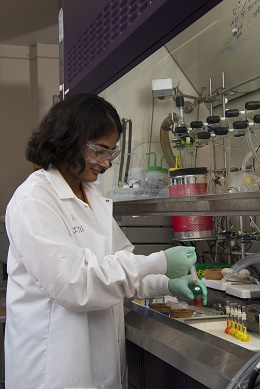
Nanocrystals prepared with target functionality in mind. You will work closely with physicists, spectroscopists and theorists who inform our synthetic work. We strive to understand the
effects of particle size, shape, internal heterostructuring, ectornic structure, and surface structure/functionalization on nanocrystal properties and to optimize these properties.
Our focus:
- Preparation of new compositions (core and core/shell materials, UV to visible to infrared absorbers/emitters, etc.).
- New shapes (isotropic to highly anisotropic).
- New heterostructured, hybrid, and multifunctional nanocrystals.
- Composite materials (e.g., high-density nanocrystal/sol-gel processible blends).
- Biocompatible nanocrystals (water-soluble and functionalized for binding to various biomolecules).
- Self- and directed-assembly of films and composite structures.
- Nanocrystal chemical-precursor development and ligand/surfactant development.
Capabilities include:
- Facilities for synthesizing and assembling colloidal nanocrystals, and tools for thin-film preparation.
- Expertise in inorganic, organic, and materials chemistry.
- Facilities for microstructural and optical/electronic-properties characterization
of nanoscale systems.
- Suite of air-free synthesis tools from standard Schlenk techniques to specialized reactors: CEM Discover microwave reactor and Syrris FRX microfluidic flow reactor (three-pump with back-pressure regulator). Microfluidic reactor can be utilized with one of three chip options:
- Standard serpentine chip for continuous-flow synthesis and collection of nanoparticles (ideal for generation of large quantities of uniform particles).
- Custom (Dolomite) chip for free-flow electrophoretic separation of nanoparticles at high voltages.
- Custom (Dolomite) chip and chip holder for the synthesis of nanowires from substrates held in reactant flow at elevated temperature (up to ~310°C) (see "Flow SLS").
Contacts:
Jennifer Hollingsworth
Eric Bowes
